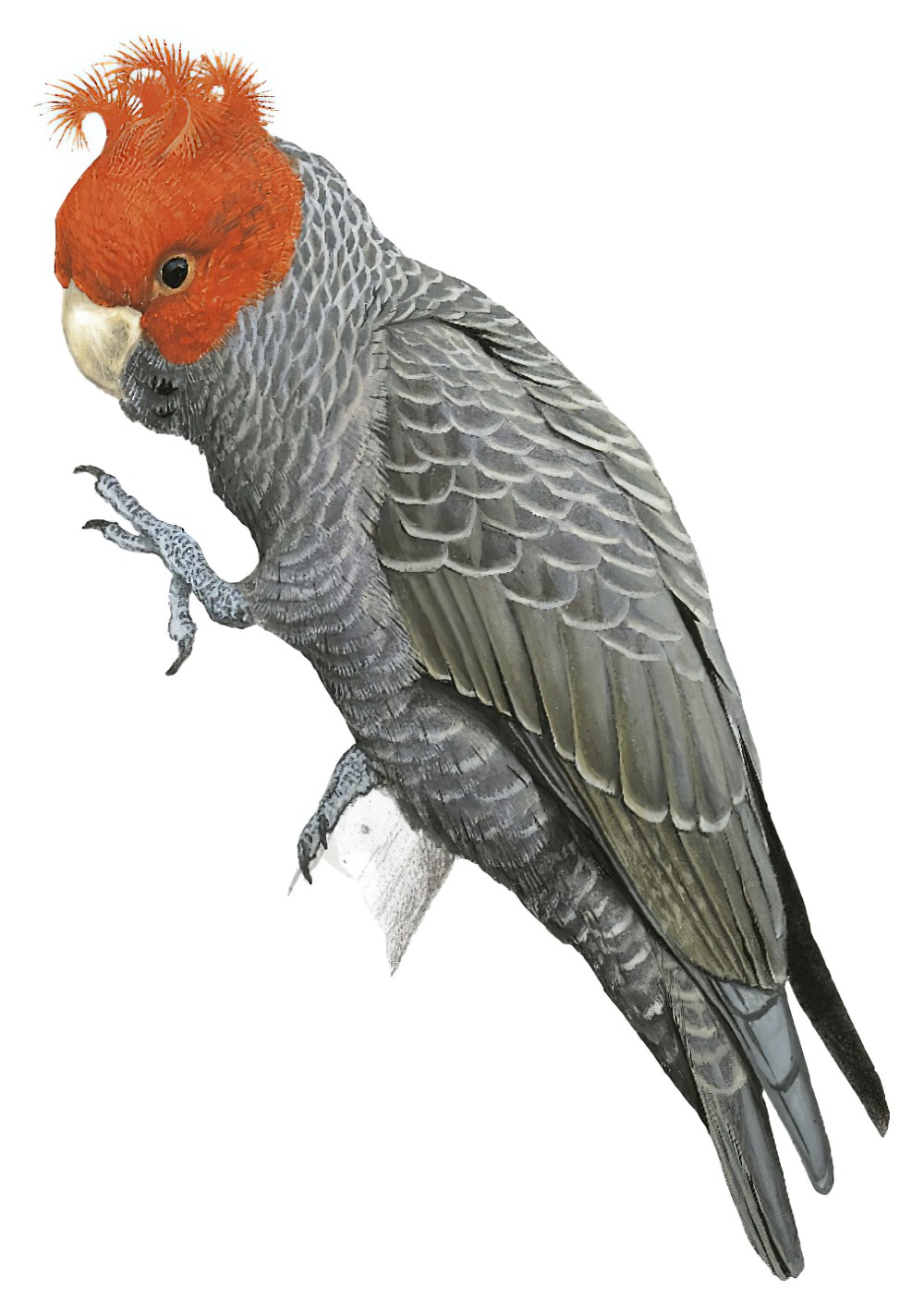Gang-gang Cockatoo / Callocephalon fimbriatum

Gang-gang Cockatoo
SCI Name:
Protonym: Psittacus fimbriatus Narr.Voy.Disc.NewS.Wales pl.opp.p.135
Taxonomy: Psittaciformes / Cacatuidae / Callocephalon
Taxonomy Code: gagcoc1
Type Locality: New South Wales, i.e. Bass River, Victoria.
Author: Grant, J
Publish Year: 1803
IUCN Status: Least Concern
DEFINITIONS
CALLOCEPHALON
(Cacatuidae; Ϯ Gang-gang Cockatoo C. fimbriatum) Gr. καλλος kallos beauty < καλος kalos beautiful; κεφαλη kephalē head; "LE CALLOCÉPHALE AUSTRAL. Callocephalon australe. (LESS.) ... L'oiseau que représentent les planches XXXIX et XL de cet Atlas a été regardé comme un cacatoës par quelques auteurs, et a été rangé avec les banksiens, ou calypthorhynchus, par MM. Vigors, Horsfield et Lafresnaye. Nous le regardons comme le lien de transition, qui conduit des banksiens, ou calypthorhynques, aux cacatoës, et nous établissons pour lui la nouvelle dénomination de callocéphale (callocephalon). ... Les plumes de la tête sont décomposées, rigidules, criniformes, et à barbes comme unilatérales et fasciculées; elles forment sur la tête une huppe touffue, dressée et érectile, simulant un cimier ou crinière. La seule espèce connue de ce genre est le callocéphale austral (callocephalon australe, Less.) ... Mais ce qui caracterisé le mâle de ce beau et rare perroquet, est le rouge de minium qui colore toutes les plumes de sa tête, de manière que les plumes de la huppe, celles du front, de l'occiput, des joues, des parotides, et de la partie du cou qui correspond au niveau de la mandibule inférieure, sont d'un rouge de feu des plus vifs; rouge à reflets cramoisis ou noirs, suivant l'obliquité des rayons lumineux." (Lesson 1837); "The sexes are alike in colour, except in the hue of their long filamentous crest, which is scarlet in the male and grey in the female" (Gould 1865); "Callocephalon Lesson, in Bougainville's Journ. Voy. Autour Globe 'Thétis,' 2, 1837, p. 311, Atlas, pl. 39, 40. Type, by monotypy, Callocephalon australe Lesson = Psittacus fimbriatus Grant." (Peters, 1937, III, p. 172).
Var. Callicephalus, Callocephalus, Callocephala.
Synon. Callocorydon, Corydon.
fimbriata / fimbriatum / fimbriatus
L. fimbriatus fringed < fimbriae fringe, border.
• "66. TROCHILUS. ... fimbriatus. 45. Tr. viridi-aureus, subtus griseus, cauda chalybea apice grisea, pectoris pennis albo fimbriatis. Mellisuga cayennensis gutture naevio. Briss. av. 3. p. 706, n. 7. t. 36. f. 2. Oiseau-mouche à gorge tachetée. Buff. hist. nat. des ois. 6. p. 31. Oiseau-mouche tacheté de Cayenne. Buff. planch. enlum. n. 276. f. 2. Spotted-necked Humming-bird. Lath. syn. I. 2. p. 772. n. 36." (J. Gmelin 1788) (Amazilia).
• "Anas fimbriata. Gesäumte Ente. So nenne ich Azara's Canard à bec rouge et plombé. ... Wangen und Kehle sind weiß, die Schultern und Steißfedern schwarz, mit fuchsrothem Rande ... die Ruderfedern weißlich, mit fuchsrother Einfassung" (Merrem 1841) (syn. Anas bahamensis rubrirostris).
• "Buarremon fimbriatus, new species SPECIFIC CHARACTERS. —Resembling Buarremon torquatus (d'Orbigny and Lafresnaye) but back paler; tail olive-greenish, as in B. phygas of northeastern Venezuela; white superciliary stripe reaching the base of the bill; breast-band conspicuously margined with white or whitish; flanks and under tail-coverts paler; wings and tail averaging longer; bill shorter." (Chapman 1923) (subsp. Arremon torquatus).
• "The weather proving uncomfortably wet gave us little chance of meeting with any variety of birds; we were fortunate enough however to fall in with some rare and uncommon cockatoos, one of which Mr. Barreillier shot, and a faithful representation of it will be found in the annexed Plate, after a design from the elegant pencil of Major-General Davies, of the Royal Artillery, to whom Governor King presented the preserved specimen. ... [plate] PSITTACUS FIMBRIATUS FRINGE CRESTED COCKATOO. From New South Wales in the Museum of Major General Davies, to whom this plate is respectfully inscribed by James Grant. Lieutenant Royal Navy." (J. Grant 1803) (Callocephalon).
• " ÉCHENILLEUR FRANGÉ. CEBLEPHYRIS FIMBRIATUS. TEMM. ... La femelle adulte ... les joues, et généralement toutes les parties inférieures, sont rayées de zigzags blancs, noirâtres et cendrés ... Nous avons figuré, pl. 250, une femelle un peu plus jeune ... toutes les pennes des ailes sont lisérées de blanc ou de cendré-clair; on voit des zigzags sur l'extrémité blanche des pennes caudales" (Temminck 1824) (Lalage).
• "Matacilla [sic] fimbriata, the gauze-tailed warbler. This small species, which is about the size of a wren, inhabits the island of Java; at least it was sent from that place to M. Temminck of Amsterdam, and from him to Mons. Vaillant. The most remarkable thing in this species is the manner in which the tail-quills are barbed; the feathers are so thinly scattered along the quills, as to have the appearance at first sight of their having been stripped; but upon examination they are so regular, that there is no doubt but the "fringe or gauze tail" is the specific character. ... The tail is longer than the body; the quills are almost black for half their length; the remainder and the barbs are of a red brown; the tail is so transparent, from the feathers being so thinly sown, that when laid upon paper you may read through it as through a piece of the finest gauze." (Wilkes 1817) (?syn. Stipiturus malachurus).
UPPERCASE: current genus
Uppercase first letter: generic synonym
● and ● See: generic homonyms
lowercase: species and subspecies
●: early names, variants, mispellings
‡: extinct
†: type species
Gr.: ancient Greek
L.: Latin
<: derived from
syn: synonym of
/: separates historical and modern geographic names
ex: based on
TL: type locality
OD: original diagnosis (genus) or original description (species)












